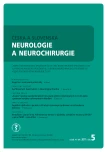Vyšetření očních pohybů v neurologické praxi
Autoři:
C. Bonnet 1; J. Hanuska 2; A. Dombrowski 3; E. Ruzicka 1
Působiště autorů:
Department of Neurology and Centre for Clinical Neurosciences, Charles University, Prague, First Faculty of Medicine and General University Hospital, Prague, Czech Republic
1; Student, Charles University, Prague, First Faculty of Medicine and General University Hospital, Prague, Czech Republic
2; Freelance Artist, Bad Bramstedt, Germany
3
Vyšlo v časopise:
Cesk Slov Neurol N 2011; 74/107(5): 518-526
Kategorie:
Přehledný referát
Souhrn
Vyšetření očních pohybů je důležitou součástí neurologického vyšetření, které poskytuje významné poznatky o funkci centrálního i periferního nervového systému, okohybných svalech a orbitě. Pečlivé, systematické a přesné vyšetření musí být provedeno během několika minut. Neurolog by měl být schopen interpretovat jeho nález, provést syndromologickou a topickou diagnostickou rozvahu a naplánovat další cílená vyšetření. Cílem tohoto přehledu je připomenout anatomicko-fyziologické podklady očních pohybů, ukázat postup jejich vyšetření a prezentovat hlavní patologické nálezy.
Klíčová slova:
vyšetření očních pohybů – nervus oculomotorius – nervus trochlearis – n. abducens – vestibulo-optokinetický systém
Zdroje
1. Leigh RJ, Kennard C. Using saccades as a research tool in the clinical neurosciences. Brain 2004; 127(3): 460–477.
2. Leigh Z, Zee DS. The Neurology of Eye Movements. 4th ed. New York: Oxford University Press 2006.
3. Trepel M. Neuroanatomie. 2nd ed. München, Stuttgard, Jena, Lübeck, Ulm: Von Urban & Fisher Verlag 1999.
4. Miller MJ, Mark LP, Ho KC, Haughton VM. Anatomic relationship of the oculomotor nuclear complex and medial longitudinal fasciculus in the midbrain. AJNR Am J Neuroradiol 1997; 18(1): 111–113.
5. Porter JD, Guthrie BL, Sparks DL. Innervation of monkey extraocular muscles: localization of sensory and motor neurons by retrograde transport of horseradish peroxidase. J Comp Neurol 1983; 218(2): 208–219.
6. Brazis PW. Palsies of the trochlear nerve: diagnosis and localization – recent concepts. Mayo Clin Proc 1993; 68(5): 501–509.
7. Robinson DA. The purpose of eye movements. Invest Ophthalmol Vis Sci 1978; 17(9): 835–837.
8. Cahill H, Nathans J. The optokinetic reflex as a tool for quantitative analyses of nervous system function in mice: application to genetic and drug-induced variation. PLoS One 2008; 3(4): e2055.
9. Szentagothai J. The elementary vestibulo-ocular reflex arc. J Neurophysiol 1950; 13(6): 395–407.
10. Rine RM, Braswell J. A clinical test of dynamic visual acuity for children. Int J Pediatr Otorhinolaryngol 2003; 67(11): 1195–1201.
11. Miles FA. The sensing of rotational and translational optic flow by the primate optokinetic system. Rev Oculomot Res 1993; 5: 393–403.
12. Barnes GR. Visual-vestibular interaction in the control of head and eye movement: the role of visual feedback and predictive mechanisms. Prog Neurobiol 1993; 41(4): 435–472.
13. Becker W. The neurobiology of saccadic eye movements. Metrics. Rev Oculomot Res 1989; 3: 13–67.
14. Pierrot-Deseilligny C, Gaymard B, Müri R, Rivaud S. ?Cerebral ocular motor signs. J Neurol 1997; 244(2): 65–70.
15. Gamlin PD, Gnadt JW, Mays LE. Abducens internuclear neurons carry an inappropriate signal for ocular convergence. J Neurophysiol 1989; 62(1): 70–81.
16. Judge SJ, Cumming BG. Neurons in the monkey midbrain with activity related to vergence eye movement and accommodation. J Neurophysiol 1986; 55(5): 915–930.
17. Mays LE, Porter JD, Gamlin PD, Tello CA. Neural control of vergence eye movements: neurons encoding vergence velocity. J Neurophysiol 1986; 56(4): 1007–1021.
18. Halmagyi GM, Curthoys IS. A clinical sign of canal paresis. Arch Neurol 1988; 45(7): 737–739.
19. Schubert MC, Minor LB. Vestibulo-ocular physiology underlying vestibular hypofunction. Phys Ther 2004; 84(4): 373–385.
20. Brodsky MC, Donahue SP, Vaphiades M, Brandt T. Skew deviation revisited. Surv Ophthalmol 2006; 51(2): 105–128.
21. Brandt T, Strupp M. General vestibular testing. Clin Neurophysiol 2005; 116(2): 406–426.
22. Rucker JC. An update on acquired nystagmus. Semin Ophthalmol 2008; 23(2): 91–97.
23. Kremenitzer JP, Vaughan HG jr, Kurtzberg D, Dowling K. Smooth-pursuit eye movements in the newborn infant. Child Dev 1979; 50(2): 442–448.
24. Phillips JO, Finocchio DV, Ong L, Fuchs AF. Smooth pursuit in 1- to 4-month-old human infants. Vision Res 1997; 37(21): 3009–3020.
25. von Hofsten C, Rosander K. Development of smooth pursuit tracking in young infants. Vision Res 1997; 37(13): 1799–1810.
26. Leigh RJ. The cortical control of ocular pursuit movements. Rev Neurol (Paris) 1989; 145(8–9): 605–612.
27. Knox PC, Bekkour T. Spatial mapping of the remote distractor effect on smooth pursuit initiation. Exp Brain Res 2004; 154(4): 494–503.
28. Paige GD. Senescence of human visual-vestibular interactions: smooth pursuit, optokinetic, and vestibular control of eye movements with aging. Exp Brain Res 1994; 98(2): 355–372.
29. Gaymard B, Ploner CJ, Rivaud-Pechoux S, Pierrot-Deseilligny C. The frontal eye field is involved in spatial short-term memory but not in reflexive saccade inhibition. Exp Brain Res 1999; 129(2): 288–301.
30. Pierrot-Deseilligny C, Gaymard B. Smooth pursuit disorders. Baillieres Clin Neurol 1992; 1(2): 435–454.
31. Optican LM, Zee DS, Chu FC. Adaptive response to ocular muscle weakness in human pursuit and saccadic eye movements. J Neurophysiol 1985; 54(1): 110–122.
32. Wray SH. Neuro-Ophthalmologic diseases. New York: Raven Press 1991: 659–697.
33. Vignal C, Miléa D. Neuro-ophtalmologie. Paris: Elsevier 2002.
Štítky
Dětská neurologie Neurochirurgie NeurologieČlánek vyšel v časopise
Česká a slovenská neurologie a neurochirurgie

2011 Číslo 5
- Metamizol jako analgetikum první volby: kdy, pro koho, jak a proč?
- Nejčastější nežádoucí účinky venlafaxinu během terapie odeznívají
- MUDr. Lenka Klimešová: Multioborová vizita může být klíčem k efektivnější perioperační léčbě chronické bolesti
Nejčtenější v tomto čísle
- Vývojová porucha koordinace – vývojová dyspraxie
- Kognitivní evokované potenciály
- Progredující spasticita, kognitivní deficit a nevýbavné kortikální motorické evokované potenciály jako klinické příznaky pravděpodobné primární laterální sklerózy – kazuistika
- Zkušenosti s evakuací chronického subdurálního hematomu z návrtu kalvy
